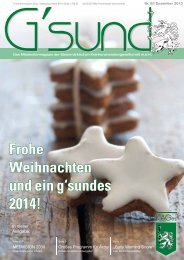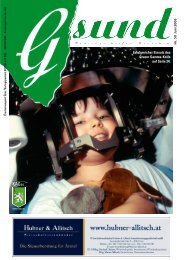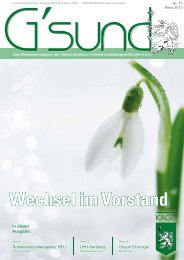Jahresbericht - Gesundheitsserver - Land Steiermark
Jahresbericht - Gesundheitsserver - Land Steiermark
Jahresbericht - Gesundheitsserver - Land Steiermark
Erfolgreiche ePaper selbst erstellen
Machen Sie aus Ihren PDF Publikationen ein blätterbares Flipbook mit unserer einzigartigen Google optimierten e-Paper Software.
the index case experienced a severe episode of vomiting while gathering with most of the residents and staff<br />
members in the dining room on November 9. In total, 17 nursing home residents and seven staff members fell<br />
ill with diarrhoea or vomiting between November 10 and 17, following the vomiting episode of the index case.<br />
In 11 of 17 cases of the nursing home residents and 5 of 7 cases of the nursing home staff the median time<br />
between exposure to the vomiting episode of the index case on November 9 and illness was 2 days, which is<br />
consistent with a point source of infection. The remaining eight cases, 6 nursing home residents and 2 staff<br />
members, showed extended time periods from the episode of vomiting of the index case to clinical onset of their<br />
illness. They can not have been generated by the index case due to direct airborne transmission. Person-toperson<br />
transmission or exposure to contaminated environment must have generated these cases.<br />
The index case was hospitalised on November 10 in a hospital situated 5 km apart from the nursing home.<br />
Another 7 cases of the nursing home residents were admitted in that hospital at the same Department<br />
(Department for Internal Medicine), 4 cases on November 11, 1 case on November 14 and 2 cases on November<br />
17. Clinicians and the local public health officer primarily suspected the increased number of hospitalisation at<br />
the Internal Medicine Department to be due to an outbreak of salmonella infections in the nursing home.<br />
Specific hygienic precautions against person-to-person transmission were not considered at the time when the<br />
cases were admitted. Between November 11 - 28, 2004, ten of the 46 hospital patients at the Internal Medicine<br />
Department (22%) and 18 persons of the 60 staff members having been on duty at the Internal Medicine<br />
Department (30%) fell ill with vomiting or diarrhoea (Figure 3). Interviews with the department staff revealed<br />
that direct contacts have occurred between cases of the nursing home and the staff. None of the 8 nursing home<br />
cases was isolated in a side room for cohort care.<br />
Outbreak Control<br />
At the nursing home, the infection control nurse suspected norovirus based on clinical and epidemiological<br />
features on November 15, six days after the index case in the nursing home had occurred. Hygienic measures<br />
for controlling norovirus in institutional settings were implemented without waiting for virological<br />
confirmation. Further 2 cases among the nursing home residents occurred within 2 days after the measures have<br />
been applied.<br />
At the hospital, the responsible health authorities decided to test cases’ stool samples for norovirus on<br />
November 17, after a total of 16 cases have occurred within 7 days. As soon as laboratory results confirmed<br />
norovirus infection (November 18), the infection control practitioner of the hospital began to implement<br />
specific control measures such as enforced hygiene for the personnel and appropriate environmental<br />
decontamination On November 21 these control measures were in place at the department. Thereafter, another<br />
2 persons of the Department staff (on Nov. 23, 26) and another 2 subjects of the hospital patients (on Nov. 26,<br />
28) fell ill with symptoms compatible with norovirus infection.<br />
Discussion<br />
Norovirus is easily spread from person to person by faecal-oral route and via aerosols. The virus is able to<br />
survive in the environment for many days which allows producing a continuous source of infection (14, 22, 30,<br />
31). The infectious dose is thought to be very low. The risk of being infected in a susceptible individual<br />
following an infectious contact has been estimated to be at 21% (risk of transmission) (32). Large numbers of<br />
people congregating provide an ideal environment for the rapid spread of this disease (33). Healthcare settings<br />
tend to be particularly affected by outbreaks of norovirus. Hospital patients and nursing home residents<br />
represent high-risk populations for the transmission of gastrointestinal illness. The residents are likely to be<br />
34
















